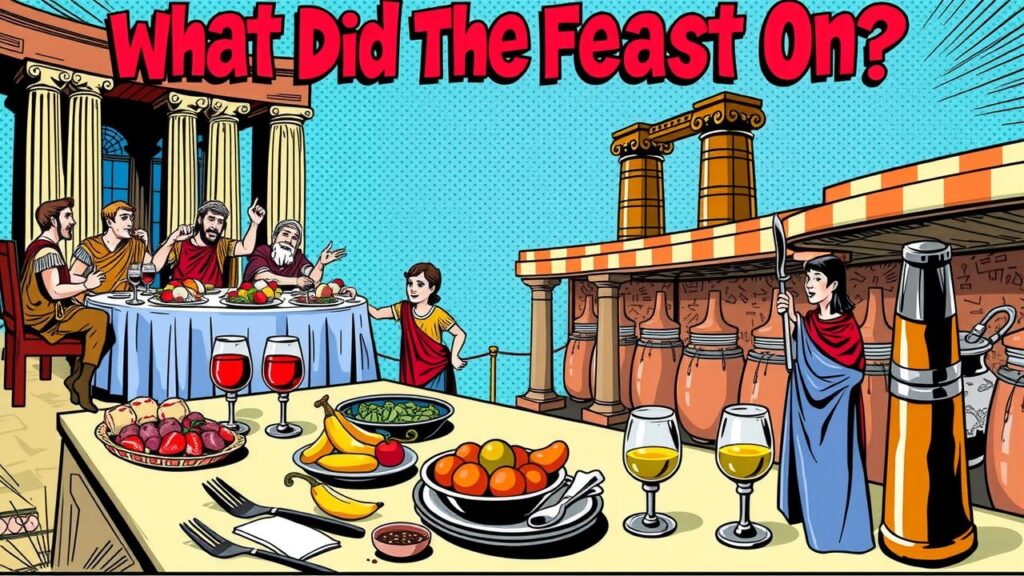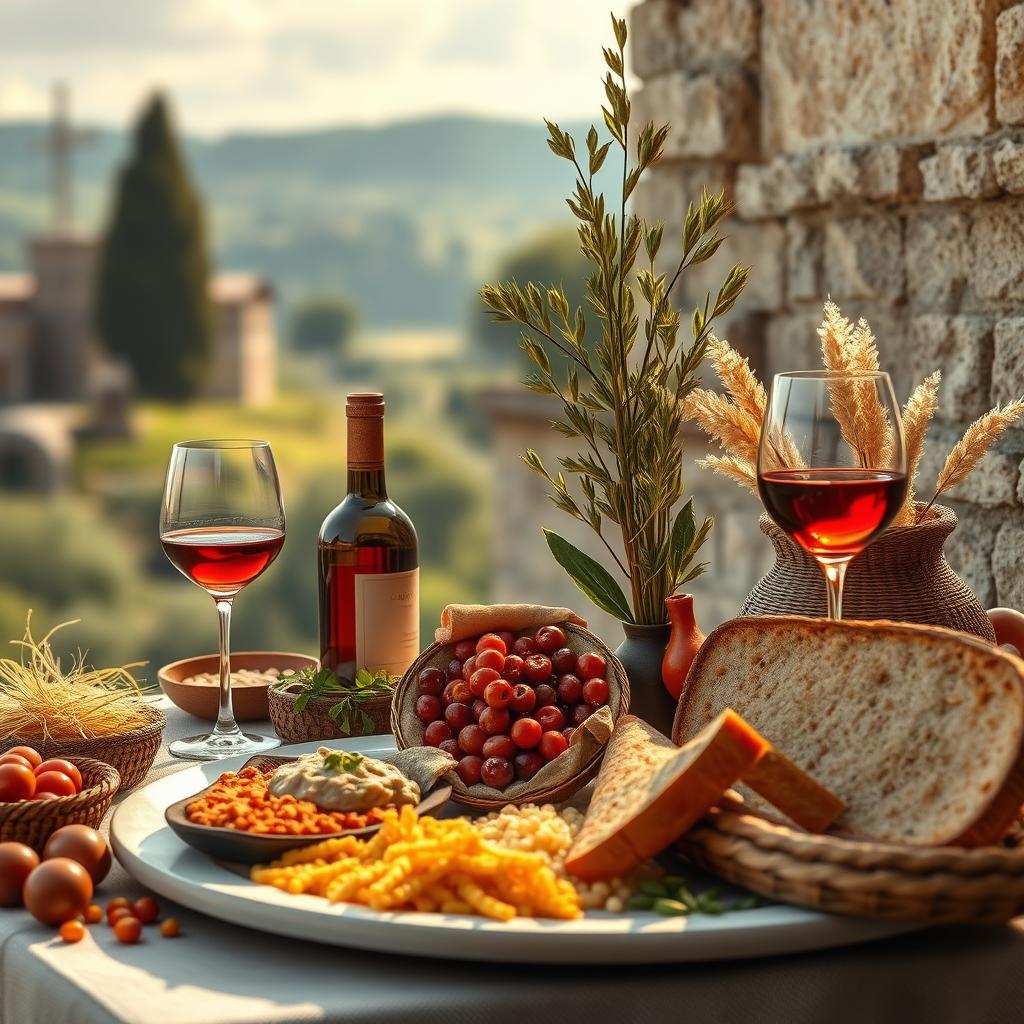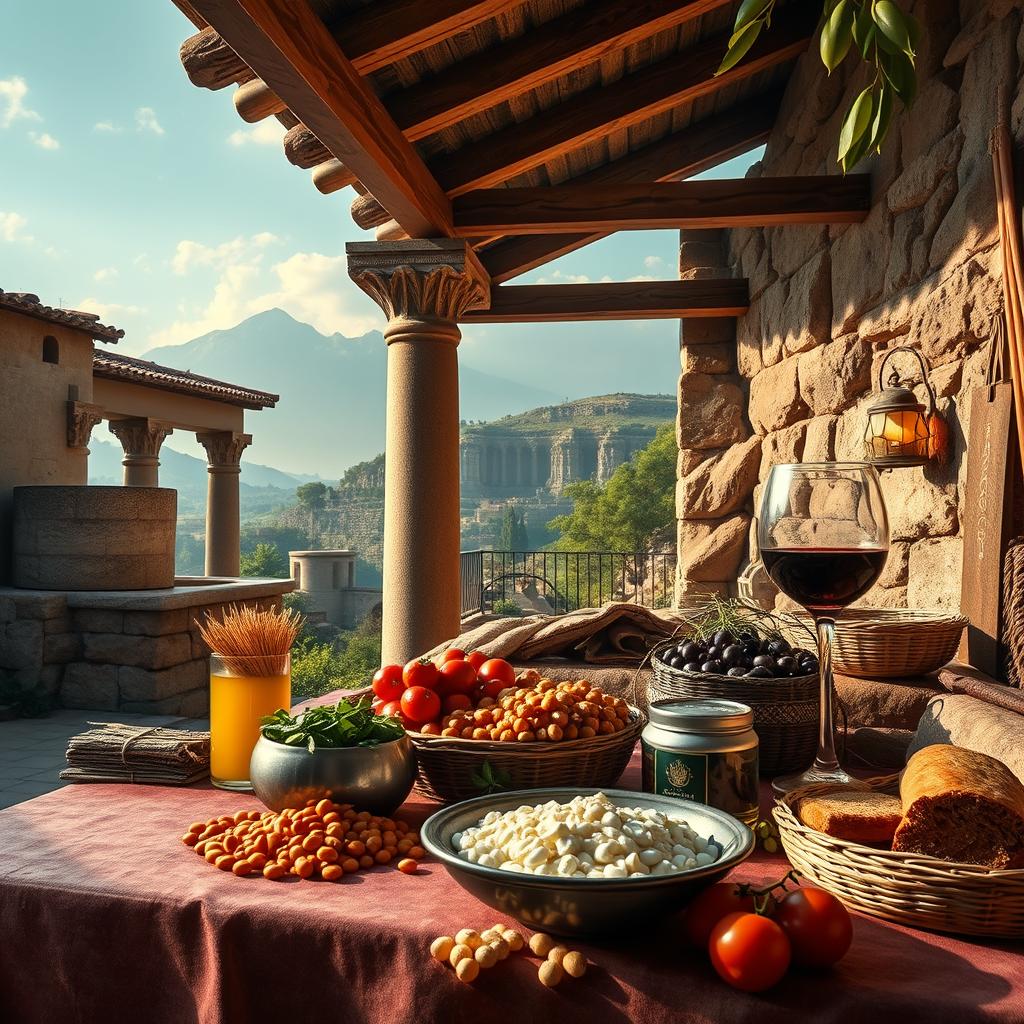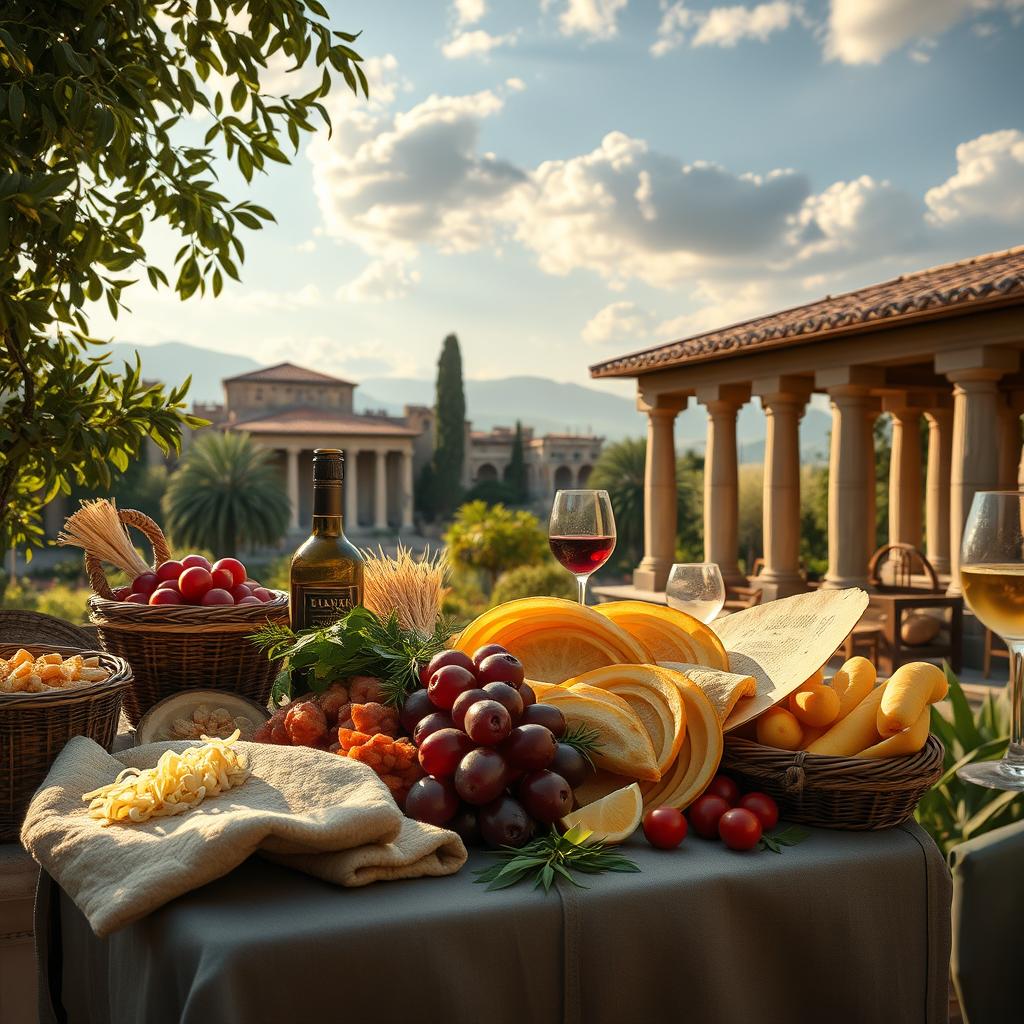The food culture of ancient Rome was incredibly diverse, showcasing the range of regions within the vast empire. Romans primarily relied on three staple items: grains like wheat, olive oil, and wine. Bread played a crucial role in their diet, varying by social class; wealthier individuals enjoyed finer types while the poorer classes had simpler options. Vegetables such as garlic and cabbage were common alongside legumes. Fruits like apples and grapes were popular too, especially since grapes were key for wine making. Meats varied significantly between classes, with richer Romans enjoying more variety than the lower ones did. Meals included a light breakfast and a bigger dinner often filled with herbs and spices that brought flavor to their dishes. Feasting also played an important role in festivals and social gatherings reflecting its significance in Roman life.

The Diversity of Ancient Roman Food Culture
The food culture of ancient Rome was incredibly diverse, shaped by the vast expanse of the Roman Empire and its many provinces. Romans primarily relied on three staple food items: grains, especially wheat, olive oil, and wine. Bread played a crucial role in their diet, with different types made from wheat flour serving various social classes. Vegetables like garlic, onions, leeks, cabbage, and lentils were widely consumed, while fruits such as apples, pears, cherries, and grapes were popular, the latter being essential for wine production. Meat consumption varied significantly; the wealthy enjoyed pork, beef, and game, while the poorer classes often faced limited access to meat. Coastal regions favored fish and seafood, with fish sauce, known as garum, commonly used as a condiment. Meals were structured around a light breakfast, a substantial lunch, and a main evening meal. The wealthy hosted lavish banquets with multiple courses and entertainment, while the lower classes settled for simpler fare. Romans enhanced their dishes with herbs and spices, frequently using cumin, coriander, and saffron. Food also played a central role in festivals and religious rituals, highlighting its importance in social and cultural life. Additionally, Romans excelled in food preservation methods, including salting, smoking, and drying, further reflecting the richness of their food culture.

Staple Foods: Grains, Olive Oil, and Wine
The foundation of the ancient Roman diet rested on three key staples: grains, olive oil, and wine. Grains, particularly wheat, were central to their meals and were primarily used to make bread. Different social classes enjoyed various types of bread, from the coarse loaves of the lower classes to the fine white bread favored by the elite. Olive oil was another crucial component, used not just for cooking but also as a dressing for vegetables and a dip for bread. It was a symbol of wealth and health in Roman society. Wine was omnipresent, consumed daily by people of all ages and classes, often mixed with water or flavored with herbs. The vast production of grapes facilitated this, making wine an integral aspect of Roman social life, whether in everyday meals or grand banquets.
The Role of Bread in Roman Diet
Bread was a cornerstone of the Roman diet, reflecting both the agricultural practices and the social hierarchy of the time. Made primarily from wheat flour, bread came in various forms and qualities. The wealthy enjoyed fine, white loaves, while the lower classes often consumed coarser, darker bread made from mixed grains, such as barley or spelt. This disparity in bread quality mirrored the broader differences in diet and lifestyle between social classes.
Bread was not just a staple food; it was also symbolic of sustenance and community. It accompanied nearly every meal, serving as a base for other foods or a vehicle to soak up sauces and juices. Romans often used bread to scoop up food, a practice that highlighted the importance of this staple in their culinary tradition.
In addition to its everyday use, bread played a significant role in religious and cultural practices. It was common for bread to be offered in sacrifices to the gods during festivals. The act of breaking bread together was also a social ritual, fostering a sense of community among diners. Overall, bread was more than mere sustenance in ancient Rome; it was a vital part of their food culture, representing both nourishment and social identity.
Vegetables in the Roman Kitchen
Vegetables played a significant role in the diet of ancient Romans, reflecting the agricultural practices and regional diversity of the Empire. Staples such as garlic, onions, leeks, and cabbage were commonly found in Roman kitchens. These vegetables were not just side dishes; they were often incorporated into main meals, served in stews or mixed with grains. Legumes, particularly lentils, were another vital component, providing essential protein, especially for the lower classes who had limited access to meat.
The Romans were also known for their love of fresh and pickled vegetables. Cabbage, for instance, was not only consumed fresh but also fermented, creating a popular dish known as sauerkraut. This preservation method was practical, allowing vegetables to last longer and providing flavor variations throughout the year. Additionally, the Romans utilized herbs like coriander and parsley to enhance the taste of their vegetable dishes, showcasing their appreciation for flavor.
Seasonality influenced what vegetables were available, leading to a variety of dishes throughout the year. In summer, fresh vegetables were abundant, while in winter, preserved options were more common. This adaptability in their diet helped Romans maintain a balanced intake of nutrients, demonstrating their understanding of agriculture and food preservation. Overall, vegetables were not just a complement to the Roman diet but rather a foundation that supported their culinary traditions.

Popular Fruits and Their Uses
Fruits played a significant role in the diet of ancient Romans, both as a staple food and as a symbol of luxury. Some of the most popular fruits included apples, pears, cherries, and grapes. Grapes were particularly important, not only for eating fresh but also for wine production, which was a central part of Roman meals. Romans enjoyed fruits in various forms: fresh, dried, or cooked. For instance, dried figs were a common treat, often consumed as a snack or used in cooking to add sweetness to savory dishes.
The use of fruits extended beyond just consumption. They were often featured in Roman desserts and were sometimes used to flavor wines and sauces. Additionally, fruits held cultural significance, often included in religious rituals and festivals. The Romans would offer fruits to the gods, reflecting their importance in both daily life and spiritual practice. Overall, fruits enriched the Roman diet, contributing to its diversity and flavor.
- Apples: Consumed fresh and used in desserts
- Figs: Eaten fresh, dried, or used in wine
- Grapes: Made into wine and eaten as snacks
- Cherries: Used in desserts and enjoyed fresh
- Pomegranates: Valued for their juice and symbolic significance
- Pears: Eaten fresh or dried for snacks
- Plums: Dried as prunes or eaten fresh
- Dates: Commonly consumed fresh or dried for their sweetness
Meat Consumption Across Social Classes
In ancient Rome, meat consumption was a clear reflection of one’s social status. Wealthy Romans had access to a wide variety of meats, including pork, beef, and game, which they often showcased during lavish banquets. For instance, dishes featuring roasted peacock or wild boar were common at these feasts, highlighting the extravagant lifestyles of the elite. In contrast, the poorer classes had limited access to meat and often relied on cheaper sources, such as small birds or the occasional piece of cured meat. Fish and seafood were also important, especially in coastal areas, where they were more readily available. Garum, a fermented fish sauce, became a staple condiment, enjoyed by all classes but particularly favored by the wealthy. The disparity in meat consumption not only illustrated the economic divide but also played a role in the social dynamics of Rome, as feasting and sharing food were integral to both social gatherings and public life.
| Social Class | Types of Meat | Access Level |
|---|---|---|
| Wealthy | Pork, Beef, Game | High |
| Middle Class | Pork, Chicken, Goat | Moderate |
| Lower Class | Fish, Occasionally Pork or Chicken | Low |
The Importance of Fish and Seafood
Fish and seafood played a significant role in the diet of ancient Romans, particularly for those living near the coast. The variety of fish available was vast, ranging from everyday catches like sardines and mullet to more luxurious options such as tuna and eel. These foods were not only plentiful but also provided essential nutrients, making them a staple for many families. In fact, fish sauce, known as garum, was a highly prized condiment made from fermented fish and was used to enhance the flavor of numerous dishes. Its popularity crossed social classes, with wealthier Romans often enjoying gourmet versions made from high-quality fish. The Romans also had advanced techniques for preserving seafood, including salting and drying, which allowed for long-term storage and transportation across the empire. This ability to preserve food ensured that fish and seafood remained a vital part of the Roman diet, contributing to the overall diversity and richness of their culinary culture.

Daily Meal Structure in Ancient Rome
In ancient Rome, the daily meal structure was quite organized, reflecting the lifestyle and social status of its citizens. Romans typically started their day with a light breakfast called ientaculum. This meal often included bread, cheese, and perhaps some fruit like apples or pears, providing them with a simple yet nutritious start to the day.
As the day progressed, lunch, or prandium, followed. This meal was more substantial than breakfast and could include cold meats, leftovers from the previous day’s cena, and more fruits and vegetables. For the working class, prandium was often a quick, practical meal, while wealthier Romans might enjoy a variety of dishes.
The main meal of the day, cena, was served in the evening and was the most important meal for Romans. For the lower classes, cena consisted of simple fare, heavily reliant on grains, legumes, and occasionally meat or fish. In contrast, the wealthy indulged in elaborate feasts with multiple courses, featuring extravagant delicacies and sometimes even entertainment. Such banquets highlighted the social status of the hosts and often included imported foods from across the empire, showcasing the diversity and richness of Roman cuisine. Overall, the structure of daily meals not only catered to the nutritional needs of Romans but also played a significant role in their social interactions and cultural practices.
Banquets: Feasts of the Wealthy
In ancient Rome, banquets were lavish affairs that showcased the wealth and status of the host. Wealthy Romans would often host extravagant dinners known as ‘cena,’ which could last for hours, featuring multiple courses and a variety of dishes. These banquets were not just about the food; they were social events where guests displayed their sophistication and taste. Exotic ingredients were highly prized, and the menu might include delicacies such as peacock, dormice, and even flamingo, prepared in elaborate ways.
The presentation of food was just as important as the meal itself. Dishes were often served in intricate designs and garnished artistically to impress guests. For instance, dishes might be shaped like animals or decorated with colorful fruits and herbs. Entertainment was also a key component of these feasts, with musicians, dancers, and even poets performing for the guests.
Drinks flowed freely at these banquets, with wine being the beverage of choice, often mixed with spices or sweetened with honey. The use of garum, a fermented fish sauce, added a unique flavor to many dishes. For the wealthy, the experience of dining was about indulging in rich flavors, showcasing their culinary prowess, and reinforcing social ties among the elite of Roman society.
Flavoring Food with Herbs and Spices
In ancient Rome, flavoring food with herbs and spices was an essential aspect of culinary practice, enhancing the taste of everyday dishes and elaborate feasts alike. Romans used a variety of herbs such as thyme, rosemary, and mint to elevate the flavors of their meals. Spices like cumin and coriander were prized for their aromatic qualities and were often added to dishes to provide depth and complexity.
Saffron, known for its vibrant color and unique flavor, was another popular choice, especially among the wealthy. The use of these flavorings not only made food more enjoyable but also reflected the social status of the individual. For example, the wealthy could afford a wider range of exotic spices that were imported from distant lands, while the poorer classes relied on more common herbs from their gardens.
Fish sauce, or garum, was a staple condiment made from fermented fish and was used to add umami flavor to many dishes. It was often drizzled over vegetables and meats, highlighting the Roman preference for bold flavors. The blending of local and imported flavors created a diverse palette that mirrored the vastness of the Roman Empire, making each meal a reflection of the rich culinary influences at play.
Feasting in Festivals and Religious Rituals
Feasting played a crucial role in ancient Roman festivals and religious rituals, highlighting the importance of food in their social and cultural life. Major festivals, such as Saturnalia and Ludi Romani, featured abundant food and drink, transforming public spaces into vibrant celebrations. During these events, communities gathered to share meals, reinforcing social bonds and collective identity.
Religious practices often included offerings to the gods, which involved preparing elaborate meals. For instance, during the festival of Vulcanalia, Romans would prepare dishes featuring roasted meats and grains as sacrifices to the god of fire. These feasts were not only acts of devotion but also occasions for the community to come together, enjoying food and drink while participating in prayers and rituals.
The diversity of food available during these celebrations reflected the vastness of the Roman Empire. Foods imported from various provinces added exotic flavors and ingredients, showcasing the empire’s wealth and reach. Wealthier citizens often hosted grand banquets at these times, featuring multiple courses and rare delicacies, while the less fortunate participated in communal feasts with simpler fare. Overall, food was a centerpiece of both public and private celebrations, symbolizing abundance, gratitude, and community.
Advancements in Food Preservation Techniques
The Romans made significant advancements in food preservation, which helped them manage the diverse food resources available throughout their vast empire. Techniques such as salting, smoking, and drying were commonly used to extend the shelf life of various foods. For instance, salting was particularly important for preserving fish and meats, making it easier to store and transport them. This process involved covering the food in salt to draw out moisture, preventing spoilage.
Another notable method was drying, which was often used for fruits and vegetables. By removing moisture, dried foods could be stored for long periods, allowing Romans to enjoy seasonal produce year-round. Herbs and spices, too, were often dried and stored, adding flavor to meals even when fresh ingredients were unavailable.
Smoking was another technique employed primarily for preserving fish and some meats. This method not only helped in preservation but also added a unique flavor that was highly appreciated in various dishes. Together, these preservation methods played a crucial role in the daily life of Romans, ensuring a stable food supply and allowing for a varied diet, regardless of the season.
Frequently Asked Questions
1. What were the main ingredients in Roman meals?
The main ingredients in Roman meals included grains like wheat and barley, vegetables, fruits, meats such as pork and fish, and cheese. They often used herbs and spices for flavor.
2. Did Romans eat the same foods every day?
No, Romans had a varied diet and ate different foods depending on the occasion and their social status. Wealthy Romans enjoyed more luxurious meals, while the poor had simpler dishes.
3. What was a typical Roman feast like?
A typical Roman feast, called a ‘convivium,’ often lasted several hours and included multiple courses. Guests reclined on couches while enjoying food, wine, and entertainment.
4. How did Romans prepare their food?
Romans used various cooking methods such as boiling, baking, roasting, and frying. They often cooked in large pots over open fires and used ovens for bread and pastries.
5. What role did wine play in Roman dining?
Wine was an essential part of Roman dining. It was consumed with most meals and often diluted with water. Romans also flavored their wine with spices and herbs.
TL;DR Ancient Roman food culture was diverse, centered around staple items like grains, olive oil, and wine. Bread was fundamental, and various vegetables and fruits were commonly consumed. Meat intake varied by social class, with the wealthy enjoying more options. Fish and seafood, especially garum, were important, and meals followed a structured routine. Banquets showcased luxury, while herbs and spices flavored dishes. Feasting was vital in festivals and religious customs, and Romans advanced food preservation methods.

